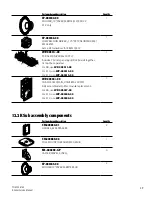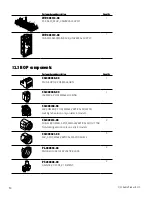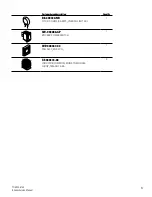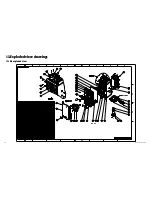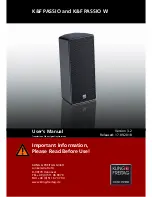
37
TD-000487-00
K Series Service Manual
9.7 Fan behavior
There may not be a problem with the fan itself due to firmware changes. Please see “3.1 Firmware revisions and program
numbers” on page 8. On newer models the fan does not turn on until the BOP reaches a high temperature condition.
On older models the fan runs all the time, except in standby-mode.
Symptoms:
•
Fan is loud - making a clicking sound
•
BOP is hot to the touch and fan doesn’t turn on
Failure verification:
•
Apply an external DC voltage (using a DC power supply) to the fan to verify the symptom
•
Fan is very dirty or sticky affecting the rotation and noise
•
Temperature sensor has failed or does not have thermal grease applied.
Repair notes:
•
Cleaning a dirty fan is not recommended - replace the fan with a new one (QSC part number WP-000367-00).
•
If the fan does not spin with a DC voltage applied to it, also check the fan drive circuit on the input/DSP board. C42, Q7,
or R70 may have failed.
•
A failed temperature sensor with Vout shorted to ground could turn the fan on full-speed indefinitely. Alternatively, a
temperature sensor with Vout shorted to the voltage on R78 could turn off the fan completely.
•
Always check for thermal grease application on the temperature sensor
9.8 Internal wiring harness
Wiring harness problems tend to occur more often in the K8, K10, and K12 models than in the KSub. Sometimes the wires
to the woofer (green and green/black) disconnect from the transducer terminals because they are too taut. If this happens,
make some slack in the wires and crimp new faston connectors on them before reconnecting.
Symptoms:
•
missing or intermittent high and/or low frequencies
•
crackling noises in loudspeakers
Failure verification:
•
A faston connector is disconnected from one of the terminals on the
LF or HF transducers.
•
A wire is loose inside the black molex connector that connects to the
amplifier
Repair notes:
•
Plug a low-distortion audio sine wave generator into a 1/4” or XLR
input connection on the amplifier module. Gradually sweep the
frequency from 20 Hz to 20 kHz. All frequencies should be audible
and free of distortion or rattling. You should notice the sound cross-
ing over from the woofer to the horn at about 2 kHz. If one of the
transducers is disconnected internally because of the wiring harness,
it will be very obvious with the sine-wave sweep.
Figure 9.10 - One of these fastons can disconnect
easily from the LF transducer’s terminals
Содержание K8
Страница 2: ...2 QSC Audio Products LLC...



























